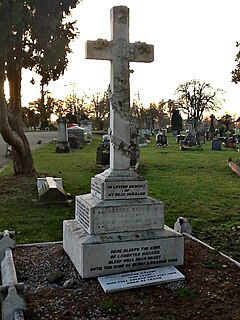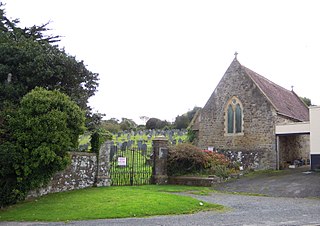
West Norwood Cemetery is a 40-acre (16 ha) rural cemetery in West Norwood in London, England. It was also known as the South Metropolitan Cemetery. One of the first private landscaped cemeteries in London, it is one of the "Magnificent Seven" cemeteries of London, and is a site of major historical, architectural and ecological interest.

Nunhead Cemetery is one of the Magnificent Seven cemeteries in London, England. It is perhaps the least famous and celebrated of them. The cemetery is located in Nunhead in the London Borough of Southwark and was originally known as All Saints' Cemetery. Nunhead Cemetery was consecrated in 1840 and opened by the London Cemetery Company. It is a Local Nature Reserve.

Anfield Cemetery, or the City of Liverpool Cemetery, is located in Anfield, a district of Liverpool, Merseyside, England. It lies to the northeast of Stanley Park, and is bounded by Walton Lane to the west, Priory Road to the south, a railway line to the north, and the gardens of houses on Ince Avenue to the east. The cemetery grounds are included in the National Register of Historic Parks and Gardens at Grade II*.

Witton Cemetery, which opened in Witton in 1863 as Birmingham City Cemetery, is the largest cemetery in Birmingham, England. Covering an area of 103 acres (0.42 km2), it once had three chapels; however, two of these were demolished in 1980. The cemetery would perform up to 20 burials a day; however, it was declared "full to capacity" in December 2013, allowing burials only in existing family plots, or of babies or cremated remains. Extra capacity was therefore provided at the nearby New Hall Cemetery. The cemetery office was opened in 1999.

Undercliffe Cemetery is located between Otley Road and Undercliffe Lane in the Bolton and Undercliffe ward, Bradford, West Yorkshire, England. The cemetery stands atop a hillside overlooking the city and contains some very impressive Victorian funerary monuments in a variety of styles. It is a notable example of a Victorian cemetery where a number of rich and prominent local residents have been buried, notably mill owners and former mayors. Undercliffe Cemetery is grade II* listed by English Heritage in their Register of Parks and Gardens of Special Historic Interest in England.

Hither Green Cemetery opened as Lee Cemetery in 1873 is a large cemetery located on Verdant Lane, London, England. The cemetery is situated between Catford, Hither Green, Grove Park and Lee. Next to Hither Green Cemetery is Lewisham Crematorium that was opened in 1956.

St Pancras and Islington Cemetery in East Finchley, North London while situated in the London Borough of Barnet is actually two cemeteries, owned by two other London Boroughs, Camden and Islington. The fence along the boundary which runs west to east between the two parts of the cemetery has been removed, although the line of it is still marked.

Brockley and Ladywell Cemeteries were opened within one month of each other in 1858 and are sited on adjacent plots of previously open land. The two component parts are characteristic examples of the first wave of Victorian public cemeteries and are now part of the Brockley Conservation Area.

Lambeth Cemetery is a cemetery in Tooting, in the London Borough of Wandsworth. It is one of three cemeteries owned by Lambeth London Borough Council, the others being West Norwood Cemetery and Streatham Cemetery.

Queen's Road Cemetery is a cemetery in Croydon, England. It opened in 1861, and was followed in 1897 by the larger Croydon Cemetery in Mitcham Road. Both cemeteries are now managed by the London Borough of Croydon.

Locksbrook Cemetery is a municipal cemetery located in Lower Weston, Bath, England. It was opened in 1864 as Walcot Cemetery, and occupies 12 acres (4.9 ha), originally serving the parishes of Walcot, Weston and St Saviour’s. The cemetery was closed for general use in 1937 with over 30,000 interments there, though additional burials in existing graves continue. The majority of the cemetery was for about 29,500 burials from Walcot parish, with the north of the cemetery for Weston and St Saviour parishes.

Welford Road Cemetery is a public cemetery in Leicester, England.

Reading Old Cemetery is in the east of Reading, Berkshire, England. It is located immediately to the east of Cemetery Junction, a major road junction in Reading. The cemetery is Grade II listed.

The English coastal city of Brighton and Hove, made up of the formerly separate Boroughs of Brighton and Hove in East Sussex, has a wide range of cemeteries throughout its urban area. Many were established in the mid-19th century, a time in which the Victorian "cult of death" encouraged extravagant, expensive memorials set in carefully cultivated landscapes which were even recommended as tourist attractions. Some of the largest, such as the Extra Mural Cemetery and the Brighton and Preston Cemetery, were set in particularly impressive natural landscapes. Brighton and Hove City Council, the local authority responsible for public services in the city, manages seven cemeteries, one of which also has the city's main crematorium. An eighth cemetery and a second crematorium are owned by a private company. Many cemeteries are full and no longer accept new burials. The council maintains administrative offices and a mortuary at the Woodvale Cemetery, and employs a coroner and support staff.

St Woolos Cemetery is the main cemetery in the city of Newport, Wales situated one mile to the west of the Church in Wales cathedral known by the same name. It contains four chapels, and various ornate memorials dating back to the early Victorian period, and was the first municipally constructed cemetery in England and Wales. It remains in use to this present day as the main cemetery for burials in Newport, and has been used as a filming location for the BBC series, Doctor Who as well as Sherlock.
The two Camberwell cemeteries are close to one another in Honor Oak, south London, England. Both have noteworthy burials and architecture, and they are an important source of socioeconomic data in recording the historical growth and changing demography in the community for the Southwark area since 1855.

Hollybrook Cemetery is a cemetery in Shirley Warren, Southampton, England containing around 53,000 graves as of August 2012 and still open to new burials as of March 2016. It is the oldest and most active cemetery in Southampton.

East-the-Water Cemetery was the Church of England burial ground for East-the-Water, once a separate village but now a suburb of Bideford, in Devon, England. Located on Barnstaple Road, the cemetery as of 2018 is abandoned and neglected, and the Victorian cemetery chapel is a dangerous structure on the verge of collapse. Burials in Bideford now take place at Bideford Higher Cemetery.

Tiverton Cemetery is the burial ground for the town of Tiverton in Devon. The cemetery covers eight acres and is owned and maintained by Mid Devon Council.

Streatham Cemetery is a cemetery on Garratt Lane in Tooting, London; it is one of three cemeteries managed by Lambeth London Borough Council, the others being West Norwood Cemetery and Lambeth Cemetery. Both Streatham and Lambeth Cemeteries are located within the London Borough of Wandsworth.
























